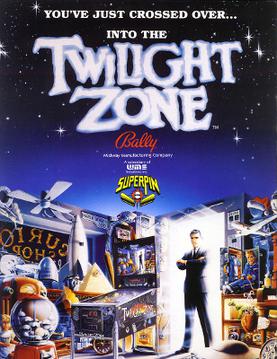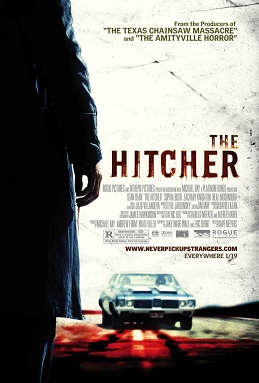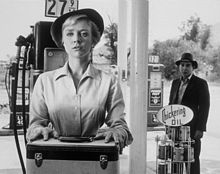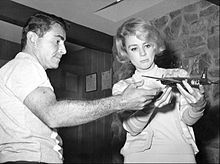
The Hitchhiker's Guide to the Galaxy is a comedy science fiction franchise created by Douglas Adams. Originally a 1978 radio comedy broadcast on BBC Radio 4, it was later adapted to other formats, including novels, stage shows, comic books, a 1981 TV series, a 1984 text adventure game, and 2005 feature film.

The Hitch-Hiker is a 1953 American independent film noir thriller co-written and directed by Ida Lupino, and starring Edmond O'Brien, William Talman and Frank Lovejoy. Based on the 1950 killing spree of Billy Cook, the film follows two friends who are taken hostage by a murderous hitchhiker during an automobile trip to Mexico.
"Walking Distance" is episode five of the American television series The Twilight Zone. It originally aired on October 30, 1959. The episode was listed as the ninth best episode in the history of The Twilight Zone by Time magazine.
The vanishing hitchhiker is an urban legend in which people travelling by vehicle, meet with or are accompanied by a hitchhiker who subsequently vanishes without explanation, often from a moving vehicle.

Towel Day is celebrated every year on 25 May as a tribute to the author Douglas Adams by his fans. On this day, fans openly carry a towel with them, as described in Adams' The Hitchhiker's Guide to the Galaxy, to demonstrate their appreciation for the books and the author. The commemoration was first held 25 May 2001, two weeks after Adams' death on 11 May.

The Hitcher is a 1986 American thriller film directed by Robert Harmon and written by Eric Red. It stars Rutger Hauer as the title character, a murderous hitchhiker who stalks a young motorist across the highways of West Texas. Jeffrey DeMunn and Jennifer Jason Leigh appear in supporting roles.

Return to Glennascaul, also known as Orson Welles' Ghost Story, is a 1951 short film starring Orson Welles. It was written and directed by Hilton Edwards, produced by Micheál Mac Liammóir for Dublin Gate Theatre Productions and distributed by Arthur Mayer.

Violet Lucille Fletcher was an American screenwriter of film, radio and television. Her credits include The Hitch-Hiker, an original radio play written for Orson Welles and adapted for a notable episode of The Twilight Zone television series. Lucille Fletcher also wrote Sorry, Wrong Number, one of the most celebrated plays in the history of American radio, which she adapted and expanded for the 1948 film noir classic of the same name. Married to composer Bernard Herrmann in 1939, she wrote the libretto for his opera Wuthering Heights, which he began in 1943 and completed in 1951, after their divorce.

Wind Chill is a 2007 supernatural horror film directed by Gregory Jacobs and starring Emily Blunt and Ashton Holmes. The film was produced by the British Blueprint Pictures company, and George Clooney and Steven Soderbergh's joint company Section Eight Productions supported the project financially. The film opened in limited distribution in April 2007 in the United States, was released in the United Kingdom and Ireland in August 2007, but went directly to DVD in most other markets.
"Valley of the Shadow" is a 51-minute episode of the American television anthology series The Twilight Zone. In this episode, a reporter is held captive in a small town after he discovers its incredible secret.
"You Drive" is episode 134 of the American television anthology series The Twilight Zone. It originally aired on January 3, 1964, on CBS. In this episode, the perpetrator of a fatal hit-and-run is hounded by the car he committed the crime with. Earl Hamner Jr. reprised this story, as he had already used it in the 1954 TV series 'Justice'.

Twilight Zone is a widebody pinball machine, designed by Pat Lawlor and based on the TV series of the same name. It was first released in 1993 by Midway. This game is part of WMS' SuperPin line of widebody games alongside Star Trek: The Next Generation and Indiana Jones: The Pinball Adventure.

The Hitcher II: I've Been Waiting is a 2003 American direct-to-DVD road thriller film directed by Louis Morneau and starring C. Thomas Howell, returning as Jim Halsey, Kari Wuhrer as his girlfriend Maggie, and Jake Busey as psychotic hitchhiker Jack. It is the sequel to the 1986 film The Hitcher. The film was released on direct-to-DVD in the United States on July 15, 2003.

The Hitcher is a 2007 American road thriller film starring Sean Bean, Sophia Bush and Zachary Knighton. It is a remake of the 1986 film of the same name starring Rutger Hauer, C. Thomas Howell and Jennifer Jason Leigh. The Hitcher was directed by Dave Meyers and produced by Michael Bay’s production company Platinum Dunes.
"The Hitch-Hiker" is a short story by Roald Dahl that was originally published in July 1977 issue of the Atlantic Monthly, and later included in Dahl's short story collection The Wonderful Story of Henry Sugar and Six More. The story is about a man who picks up a hitch-hiker whilst driving to London. The pick-pocketing of a policeman's notebook during a traffic stop closely follows "Hitch-Hike", a 1960 episode of Alfred Hitchcock Presents based on a short story by Ed Lacy.

The World of Lee Evans is a BAFTA-nominated television comedy series written by and starring Lee Evans. It was produced by Granada Television for Channel 4 and aired four episodes in June 1995.

Door to Silence, also known as Door Into Silence, is an Italian horror film written and directed by Lucio Fulci and produced by Joe D'Amato. It stars John Savage. This was the last film directed by Fulci.

Two Weeks Vacation is a 1952 American animated short film produced by Walt Disney Productions and released by RKO Radio Pictures. The cartoon follows Goofy on an ill-fated vacation trip traveling cross country. It was directed by Jack Kinney and features the voices of Pinto Colvig as Goofy and Alan Reed as the narrator and a hitchhiker.

The Hitch-Hiker is a radio play written by Lucille Fletcher. It was first presented on the November 17, 1941, broadcast of The Orson Welles Show on CBS Radio, featuring a score written and conducted by Bernard Herrmann, Fletcher's first husband. Welles performed The Hitch-Hiker four times on radio, and the play was adapted for a notable 1960 episode of the television series The Twilight Zone.
A hitchhiker is someone who goes hitchhiking.
















